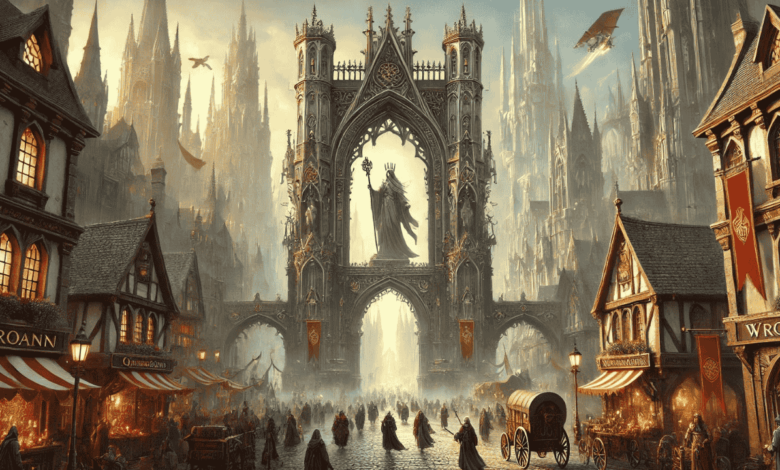Wroanns Gate: A Key Landmark in Eberron’s Sharn

Wroanns Gate is one of Sharn’s most significant and iconic landmarks, the towering metropolis of the Eberron campaign setting in Dungeons & Dragons (D&D). This district, originally named the “Gate of Galifar,” holds immense cultural and historical relevance in Breland, one of the Five Nations of Eberron. The district’s renaming to Wroanns Gate is deeply tied to the legacy of Queen Wroann ir’Wynarn, a key figure during the Last War, which marked a pivotal era in Eberron’s history.
In this article, we will explore Wroanns Gate’s historical significance, cultural implications, architectural grandeur, and economic importance, focusing on why it remains a critical point in the story of Sharn and Eberron. For fans of the D&D universe or those unfamiliar with this setting, Wroanns Gate serves as both a narrative and geographical anchor in the world-building of Eberron.
Historical Context of Wroanns Gate
Wroanns Gate was once known as the Gate of Galifar, a name that tied it to the empire of Galifar, which dominated much of Khorvaire. The gate symbolized pride and power, linking Sharn to the surrounding regions and playing a crucial role in the city’s expansion.
During the Last War, a long and brutal conflict between the Five Nations of Khorvaire, the people of Breland renamed the district to honor their monarch, Queen Wroann. Queen Wroann was an influential and charismatic leader who led Breland during the early years of the war, and her refusal to acknowledge the Cyran Princess Mishann as the rightful heir to the throne was a crucial factor in sparking the war. This renaming showed patriotism and respect for Queen Wroanns determination to protect Breland’s sovereignty.
The gate, with its towering statue of Queen Wroann, symbolized her strength and defiance, and it became a place where Brelish citizens could gather to show their support for their nation during the tumultuous years of the Last War(
The Role of Queen Wroann
Wroann was one of the pivotal figures in the history of Breland. As the ruling monarch during the outbreak of the Last War, she had a significant influence on the political landscape of Khorvaire. Wroann is remembered for her tactical genius, strong leadership, and commitment to Breland’s independence. She was, however, a divisive figure, especially among the Cyrans, who viewed her as one of the critical reasons for the Last War’s eruption. Her refusal to recognize Mishann, the Cyran claimant to the throne of Galifar, is often cited as one of the war’s triggering events.
The statue of Queen Wroann at the gate reminds us of her leadership. A towering figure holding a sword and scepter symbolizes her power and rule over Breland during a crisis.
Architectural Significance
The first impression of Wroann Gate is one of sheer grandeur and scale. This massive archway serves as the main entrance for travelers arriving in Sharn via the Old Road. Rising above the gate is an enormous tower, upon which sits the statue of Queen Wroann. The detailed craftsmanship of the arch, combined with the tower’s impressive height, makes Wroann Gate a remarkable feat of architecture within Sharn.
Architecturally, Wroann Gate is not just an entry point but a monumental structure designed to instill awe and respect in all who pass through. The design is a mix of Gothic and arcane influences, standard in the towering spires of Sharn. The gate serves as a junction where various magical and technological elements blend, such as sky-coaches (magical vehicles) that zip through the air above the gate, adding to the chaos and vibrancy of the area.
Wroann Gate as a Hub of Commerce and Traffic
Wroann Gate plays a crucial role in Sharn’s economic life. Farmers from the surrounding countryside, merchants from distant regions, and noble lords returning from Wroat, Breland’s capital, all pass through this gate. The area is bustling with activity, from the constant flow of caravans and merchants bringing goods to Sharn’s vast markets to the local vendors who set up stalls near the gate to catch the traveler’s attention.
Compared to Terminus, another central entry point in Sharn, Wroann’ Gate is more oriented toward local traffic, with farmers and merchants from surrounding regions using the gate to enter the city. The markets around Wroann Gate are filled with fresh produce, livestock, textiles, and a wide variety of other goods that make their way to the city’s inhabitants.
Key Commercial Activities
Several Dragonmarked Houses—notably House Sivis, House Deneith, and House Vadalis—have a strong presence in Wroann Gate, Providing services that meet the requirements of both local and foreign travelers. House Sivis, known for its mastery of communication and linguistic services, often provides translation and messaging services, facilitating trade between different cultures and regions. House Vadalis, famous for their animal husbandry expertise, usually works with local farmers who bring livestock into the city for sale.
These Dragonmarked Houses contribute to Wroann Gate’s reputation as a critical point for economic exchange and communication between Sharn and the surrounding territories. The area is also a key point for collecting tariffs and tolls on goods entering the city, which adds to the city’s wealth and power.
Cultural and Social Dynamics
Beyond its commercial importance, Wroann Gate serves as a microcosm of Sharn’s broader societal dynamics. As one of the major entry points into the city, Wroann Gate is a melting pot of different cultures, classes, and races. You will find travelers and merchants from all over Khorvaire and locals going about their daily business.
Despite its grandeur, the area around Wroanns Gate is associated with lower-class residents. Many people who live and work in this district are laborers, porters, and traders who depend on the steady traffic flow for their livelihood. This social stratification is a common theme in Sharn, where wealth and poverty are juxtaposed, and Wroanns Gate is no exception.
Symbolism and Politics
The symbolism of Wroanns Gate cannot be overstated. For many British citizens, the gate represents Breland’s sovereignty and Queen Wroanns legacy. It is a point of pride for the nation, reminding them of their resilience during the Last War. However, for Cyran refugees, the gate holds a different meaning. The refusal of Queen Wroann to recognize Princess Mishann as the rightful heir to the throne of Galifar is viewed by many Cyrans as an act of betrayal, making Wroanns Gate a symbol of the conflict that led to The destruction of Cyre led to the birth of the Mournland.
Cyrans traveling to Sharn often prefer to avoid Wroanns Gate, opting to enter through the Dragon Gate, which is seen as a less politically charged entrance to the city. The political tensions surrounding Wroanns Gate reflect the broader divisions between the nations of Khorvaire and the unresolved traumas of the Last War.
Conclusion
Wroanns Gate is more than just a gateway to the city of Sharn—it is a symbol of Breland’s history, Queen Wroanns leadership, and the cultural and economic lifeblood of the region. It is a testament to Sharn’s architectural grandeur, a hub of commerce and social interaction, and a political landmark charged with the weight of the Last War.
As a crucial location in the Eberron campaign setting, Wroanns Gate provides Dungeons & Dragons players and Dungeon Masters with a rich backdrop for storytelling and adventure. Its historical significance, social dynamics, and economic importance make it a location with potential for narrative exploration. Whether you are a traveler entering Sharn for the first time or a citizen navigating the bustling streets, Wroann’s Gate is where history and modern life converge dramatically.
You May Also Read: The Enigmatic Pax Dei Iron Spike: A Symbol of Peace and Unity




